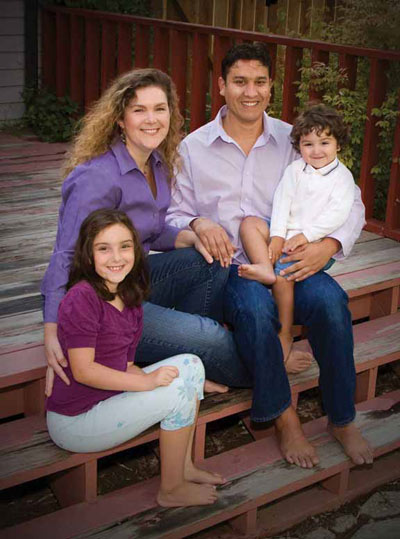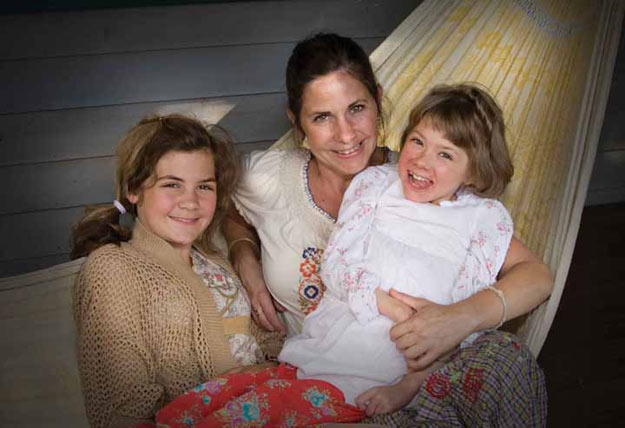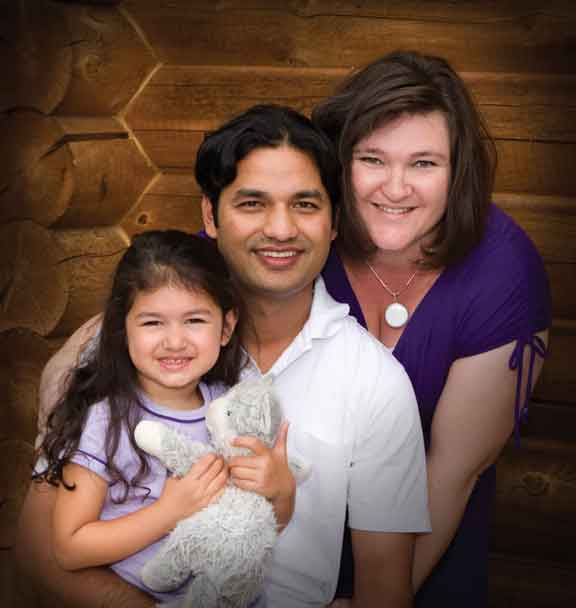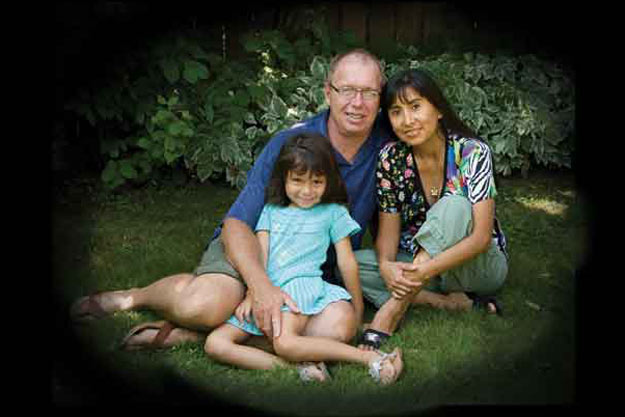Immigrants in Sandpoint
How Love brought 4 people from 4 different continents to our town
Story and photos by Marie-Dominique Verdier
The drive to explore is inherent in some people, while in others it remains dormant, and they are content to spend their entire lives in the same town or region. Yesterday’s explorers have become today’s tourists and immigrants. Yet, while tourism is basically pleasure-yearning travel, immigration is fueled by many other causes: social, economic, political and, of course, love!
I had my first “taste” of immigration as I was a toddler when my father, a French national and resident, was sent to Algeria for two years to practice medicine. Although I do not have many memories from that period, I believe it gave me a real capacity to connect with people from other cultures. My parents made it a point to teach us a strong sense of respect for the local customs; we were going to learn from the country and its people and would not impose our own world views upon the Algerians, who still had the trauma of the French occupation fresh in their minds. (Algeria had painfully gotten its independence in 1962, just five years before my family moved there.)
When it comes to relocating for living purposes, I don’t consider myself an explorer. I am one of those people who still need some familiarity. The transition from France to New Orleans was fairly easy since my sister was living in the city at that time. And of course, Louisiana had been French just 186 years before my arrival!
But moving to Sandpoint was a different story. I found it so foreign from New Orleans, my home for 10 years. At least, that was the way I felt until I met my neighbor, who, strangely enough, immediately reminded me of my sister – and this allowed for the familiarity. That was almost nine years ago. Since then, my appreciation for the people of Sandpoint has grown to a degree I never could have anticipated, and it is without hesitation that I now call Sandpoint “home.”
The love of my life, pianist Scott Kirby, took me to New Orleans, then to Sandpoint where, thanks to the love of the people, I choose to stay
 |
Gabrielle Huguenin and Mohammed Mouttaqi with their children,
Leila, 8, and Ali, 2 |
Love has been a big factor in getting other immigrants to Sandpoint as well. Pierre Huguenin came from France in the mid-1960s to settle in Sandpoint after finding love. Now two of his daughters have had their hearts stolen by foreigners: His eldest, Daniele, married Carlo Pati from Switzerland, and his fifth daughter, Gabrielle, wedded Moroccan-born Mohammed Mouttaqi. The latter two met rather dramatically in 2000 in San Rafael, Calif., when Gabrielle was almost hit by a car. She was crossing a street at an intersection with no crosswalk when the car barely missed her, thus giving fate a chance as Mohammed rushed to help her. They exchanged phone numbers.
“We had our first date three days after that, and the rest is history,” Mohammed said.
He had left North Africa and lived in the San Francisco Bay area for several years before he and his wife decided to relocate to Sandpoint, a relatively short move, and yet, a real change. “The snow was a big difference to me, but I am starting to do things outside and it’s not too bad,” he said.
Mohammed is mostly a family man who stays in touch with his relatives in Morocco and in Belgium. He also makes sure his daughter, Leila, and son, Ali, learn Arabic and celebrate the Muslim holidays.
One thing he notices is how his nationality is perceived. “Most people think I am Native American versus a Moroccan,” he said. The mistaken identity doesn’t seem to bother him; quite the contrary, his appreciation for Indians makes him see it as an honor.

Catherine Earle and daughters, Gabrielle, 12, and Alexandra, 9
In Catherine Earle’s case, if her looks do not give away her origins, wait until she speaks and you will know without a doubt that she is French. Her middle school English teacher would be shocked to learn that Catherine has made English her first language for the past 20 years: “Miss Lemaître, you will never speak English!” Although the warning inhibited her for the next 10 years, when love pointed its nose and she fell for a handsome American actor, Catherine eventually kissed the curse goodbye.
The transition between France and the United States still was not an easy one, which may sound rather surprising considering the relatively close cultures between the two countries, as opposed to the cultural differences between the United States and Morocco, for example. The most significant episode occurred when she first arrived in the Sandpoint area to meet her future in-laws. She quietly did what any decent guest would do in France: She sat on the couch and waited patiently to be told what to do or where to go next. By 7 p.m., she had been sitting for several hours and started to be really hungry. So she finally asked, shyly, “When do we eat?”
Her fiancé looked at her with surprise and informed her that everyone had already eaten.
“The crackers? That was dinner?”
It turned out that it was dinner, and if she was still hungry she was welcome to help herself to the fridge.
“I couldn’t do that,” she said.
I can relate, being French myself. There is some sort of taboo in the French culture: You just don’t go into somebody’s fridge, period. The offer to go to the fridge eventually became a menace, and after being told that she was not going to survive in this country if she could not open the fridge, she complied, with help from her fiancé.
Catherine admits that the challenges were mostly brought on by herself, her culture and expectations; today her view of Sandpoint and its people has shifted 180 degrees. There is one thing, however, that attracted her senses and heart from day one when she arrived in August 1990 in northern Idaho: the beauty and serenity of the golden fields, their sweet, soft smell, in which she found a reassuring familiarity. Yet, Catherine’s strongest appeal for Sandpoint lies in its people.
“I love my rapport with the people of Sandpoint. I feel welcome, and I am happy to raise my children here,” she said.
As much as there is no question in Catherine’s mind that she will ever move back to France, Pradeep Shrestha is hoping to relocate to his native Nepal someday, a country he and his American wife, Jennifer, bid farewell to in a matter of life or death in 2002. Jennifer had gone to Nepal as a Peace Corp volunteer in 1998 when she met Pradeep through his cousin, who happened to be her language teacher. Three years later, in July 2001, the Maoist rebels started a new wave of violence, which soared by the end of the year after a failed truce, leaving several hundred people dead. Americans, who had become a preferred target, were eventually encouraged by their embassy to leave the country as soon as possible, advice Pradeep and Jennifer took seriously.
 |
Pradeep and Jennifer Shrestha with their 4-year-old daughter Asia. Their second child, Raina, was born in September |
In two months, they sold their home as well as their belongings, bought one-way tickets to Spokane and left. Pradeep mostly misses his relatives, as well as a simpler way of life, a place where people come and go to your house without being announced, and have time, or at least make the time, to connect with their friends and family. Sandpoint was already familiar territory for Pradeep upon his return, since he and Jennifer were married here in December 2000 and spent their honeymoon at Schweitzer – a rather memorable experience for Pradeep.
“It was my first time to ski in my life. We had a great time except the skiing part,” he said. “I fell more than 50 times! When I see other people ski it looks so easy and fun, but when I ski it’s not fun!”
Ultimately, tripping on a little girl convinced him that the sport was just not for him. Yet the mountains, the evergreens, the clean air and, most of all, the friendliness and kindness of the people of Sandpoint have all contributed to making his return here a smooth transition. However, the language has remained a major issue for Pradeep, who still struggles with the English pronunciation. (To give you an idea, imagine putting a handful of marshmallows in your mouth while trying to talk: This is honestly how it feels at first for some of us foreigners!) So if you ever cross his path, don’t talk too fast, and please, don’t use any slang.
Although the language also came as a struggle for Peruvian-born Anavel Boge, the quietness of the area has proven to be the hardest issue to deal with after moving to town in 2004 as a pregnant newlywed of Michael Boge. The couple had met when Michael took up Anavel’s offer to visit Peru following a climbing trip to Ecuador. They had been exchanging e-mails while she was working for the travel agency Michael used to book his intricate schedule of bus rides from Lima to Central Peru.
“The first few months I was here I cried a lot, as it seemed like nobody was here in Sandpoint!” Anavel said. Growing up, her experience of community was dramatically different from that of Americans: “People in Peru live very close to one another, so close that they cannot keep secrets from each other.” She also had to adjust to the northern Idaho weather, as well as the sun’s year-round seemingly capricious rising and setting times, unlike in Peru where it faithfully sets 365 days a year at 6 p.m.
It was all very hard, but she told husband Michael that she would not visit her family in Peru for one year in order to learn the local culture. She started to dress warmly and followed her father-in-law’s advice to learn skiing, which, as it turns out, provides her with great joy. She remembers the first time she saw snow: “It was so special and romantic! It looked like a Christmas card,” which made her family members in South America change their mind about her being “nuts” for moving to such a cold place.
Five years later, Anavel travels twice a year to Peru to visit family and friends and to facilitate a program she and Michael founded in 2006, the Satipo Kids. The project brings funds to underprivileged kids in her hometown, thus giving them an opportunity to get public education. She has gotten used to the many “curious ideas” she first encountered in Sandpoint, and now owns her own helmet for skiing and biking, along with a life jacket for their kayak. She would even like to add a porch to their house at some point. There is one thing, however, that even now she is not accustomed to: Sandpoint is still way too quiet.
I suppose it’s all about perspective. Like delightful, spicy dishes, the world’s traditions provide ingredients for an infinite choice of flavors and points of view. My experiences living in France, Algeria, Germany, New Orleans and now Sandpoint have been extremely varied, but all so tasty!
|



